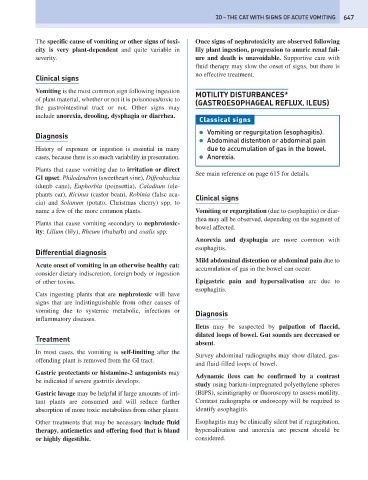Page 655 - Problem-Based Feline Medicine
P. 655
30 – THE CAT WITH SIGNS OF ACUTE VOMITING 647
The specific cause of vomiting or other signs of toxi- Once signs of nephrotoxicity are observed following
city is very plant-dependent and quite variable in lily plant ingestion, progression to anuric renal fail-
severity. ure and death is unavoidable. Supportive care with
fluid therapy may slow the onset of signs, but there is
no effective treatment.
Clinical signs
Vomiting is the most common sign following ingestion
MOTILITY DISTURBANCES*
of plant material, whether or not it is poisonous/toxic to
(GASTROESOPHAGEAL REFLUX, ILEUS)
the gastrointestinal tract or not. Other signs may
include anorexia, drooling, dysphagia or diarrhea.
Classical signs
● Vomiting or regurgitation (esophagitis).
Diagnosis
● Abdominal distention or abdominal pain
History of exposure or ingestion is essential in many due to accumulation of gas in the bowel.
cases, because there is so much variability in presentation. ● Anorexia.
Plants that cause vomiting due to irritation or direct
See main reference on page 615 for details.
GI upset: Philodendron (sweetheart vine), Diffenbachia
(dumb cane), Euphorbia (poinsettia), Caladium (ele-
phants ear), Ricinus (castor bean), Robinia (false aca-
Clinical signs
cia) and Solanum (potato, Christmas cherry) spp. to
name a few of the more common plants. Vomiting or regurgitation (due to esophagitis) or diar-
rhea may all be observed, depending on the segment of
Plants that cause vomiting secondary to nephrotoxic-
bowel affected.
ity: Lilium (lily), Rheum (rhubarb) and oxalis spp.
Anorexia and dysphagia are more common with
esophagitis.
Differential diagnosis
Mild abdominal distention or abdominal pain due to
Acute onset of vomiting in an otherwise healthy cat:
accumulation of gas in the bowel can occur.
consider dietary indiscretion, foreign body or ingestion
of other toxins. Epigastric pain and hypersalivation are due to
esophagitis.
Cats ingesting plants that are nephrotoxic will have
signs that are indistinguishable from other causes of
vomiting due to systemic metabolic, infectious or
Diagnosis
inflammatory diseases.
Ileus may be suspected by palpation of flaccid,
dilated loops of bowel. Gut sounds are decreased or
Treatment
absent.
In most cases, the vomiting is self-limiting after the
Survey abdominal radiographs may show dilated, gas-
offending plant is removed from the GI tract.
and fluid-filled loops of bowel.
Gastric protectants or histamine-2 antagonists may
Adynamic ileus can be confirmed by a contrast
be indicated if severe gastritis develops.
study using barium-impregnated polyethylene spheres
Gastric lavage may be helpful if large amounts of irri- (BIPS), scinitigraphy or fluoroscopy to assess motility.
tant plants are consumed and will reduce further Contrast radiographs or endoscopy will be required to
absorption of more toxic metabolites from other plants. identify esophagitis.
Other treatments that may be necessary include fluid Esophagitis may be clinically silent but if regurgitation,
therapy, antiemetics and offering food that is bland hypersalivation and anorexia are present should be
or highly digestible. considered.

